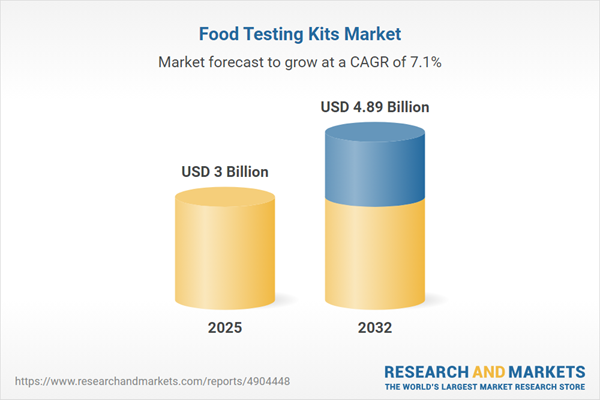Speak directly to the analyst to clarify any post sales queries you may have.
The global food testing kits market is evolving rapidly, shaped by new technologies and regulatory shifts. Senior decision-makers face increasing pressures to assure food safety, streamline compliance, and build resilient supply chains in a dynamic risk landscape.
Market Snapshot: Food Testing Kits Market Size and Growth
The Food Testing Kits Market grew from USD 2.81 billion in 2024 to USD 3.00 billion in 2025 and is projected to reach USD 4.89 billion by 2032, with an expected CAGR of 7.14%. This strong trajectory underscores sustained demand, as advanced diagnostics and regulatory mandates raise the bar for food safety solutions globally.
Scope & Segmentation Analysis
- Technology: Chromatography-based (gas and liquid chromatography), immunoassay-based, infrared spectroscopy, mass spectrometry, and PCR-based solutions.
- Target Tested: Detection of allergens, genetically modified organisms, meat species, mycotoxins, and pathogens.
- Sample Type: Analysis across cereals, grains & pulses; dairy products; fruits & vegetables; meat, poultry & seafood; nuts, seeds & spices; and packaged foods including canned goods and frozen entrees.
- End-User: Segment coverage includes large and small-to-medium food manufacturers, food service providers (cafeterias, restaurants), and research laboratories (academic and private).
- Distribution Channel: Both offline (specialty distributors, laboratory supply houses) and online channels streamline the delivery of testing kits and consumables.
- Regional Coverage: Detailed assessment spans the Americas (United States, Canada, Mexico, Latin America), Europe, Middle East & Africa (with coverage of major European, ME, and African economies), and Asia-Pacific (China, India, Japan, Australia, and key SE Asian markets).
- Company Landscape: Analysis includes leading providers such as 3M Company, Agilent Technologies, Bio-Rad Laboratories, bioMérieux, Charm Sciences, Ecolab Inc., FOSS A/S, Merck KGaA, PerkinElmer, Thermo Fisher Scientific, and others.
Key Takeaways for Senior Decision-Makers
- Technological adoption is advancing, with portable diagnostics and sophisticated analytical methods addressing diverse contamination and authenticity challenges in the food supply chain.
- Regulatory vigilance is increasing, prompting end-users to place greater emphasis on traceability, rapid detection, and validation across testing workflows.
- Supply chain adjustments, particularly in response to tariff changes and sourcing volatility, are driving investment in regional manufacturing, alternative suppliers, and inventory strategies.
- The integration of digital traceability and real-time data analytics is accelerating, supporting proactive food safety management across the chain of custody.
- Competitive differentiation hinges on service robustness, including bundled maintenance, analytics, and training to enhance customer retention and operational resilience.
- Collaboration between top companies, biotech innovators, and research institutions is spurring platform evolution and driving early access to next-generation detection technologies.
Tariff Impact on Food Testing Kit Supply Chains
Recent tariff adjustments in the United States have added complexity for companies managing inbound and outbound logistics. Higher duties on critical consumables and diagnostic instruments are causing shifts toward domestic production, alternate sourcing, and regional partnerships. These changes influence vendor strategy, procurement timelines, and inventory levels, reinforcing the need for adaptive, multi-supplier risk management.
Research Methodology & Data Sources
This report applies a robust methodology, combining primary interviews with senior laboratory and regulatory leaders and secondary research from peer-reviewed journals, industry reports, and regulatory databases. Analytical techniques include SWOT, PESTEL, and competitive benchmarking. Findings are validated by expert panels to ensure accuracy and practical relevance while upholding respondent confidentiality.
Why This Report Matters to Food Testing Kits Market Stakeholders
- Offers actionable segmentation and competitive intelligence to guide investment and product development strategy.
- Clarifies how trade policy, technological advancement, and regulation converge to influence risk and opportunity across the value chain.
- Supports proactive planning with insights into resilient supply management, regulatory compliance, and rapid market adaptation.
Conclusion
The food testing kits market is shifting in response to new technologies, regulatory demands, and evolving trade conditions. Decision-makers leveraging data-driven insights and robust strategic planning will be best positioned to lead and innovate as this landscape continues to transform.
Additional Product Information:
- Purchase of this report includes 1 year online access with quarterly updates.
- This report can be updated on request. Please contact our Customer Experience team using the Ask a Question widget on our website.
Table of Contents
3. Executive Summary
4. Market Overview
7. Cumulative Impact of Artificial Intelligence 2025
Companies Mentioned
The companies profiled in this Food Testing Kits market report include:- 3M Company
- Agilent Technologies, Inc.
- Bio-Rad Laboratories, Inc.
- bioMérieux S.A.
- Charm Sciences, Inc.
- Creative Diagnostics
- Ecolab Inc.
- FOSS A/S
- Merck KGaA
- Neogen Corporation
- PerkinElmer, Inc.
- QIAGEN N.V.
- R-Biopharm AG
- Randox Laboratories Ltd.
- Romer Labs Division Holding GmbH
- Romer Labs Inc.
- Scigiene Corporation
- Shimadzu Corporation
- Thermo Fisher Scientific Inc.
- Unisensor S.A.
- WATERS Corporation
- Zoetis Inc.
Table Information
| Report Attribute | Details |
|---|---|
| No. of Pages | 181 |
| Published | November 2025 |
| Forecast Period | 2025 - 2032 |
| Estimated Market Value ( USD | $ 3 Billion |
| Forecasted Market Value ( USD | $ 4.89 Billion |
| Compound Annual Growth Rate | 7.1% |
| Regions Covered | Global |
| No. of Companies Mentioned | 23 |









